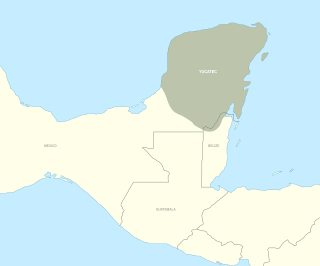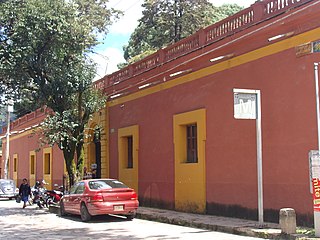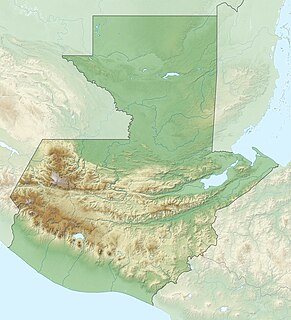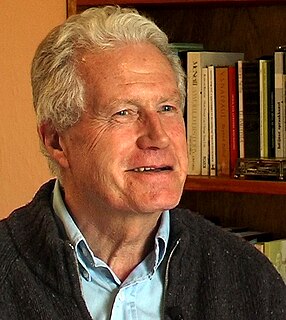
Chiapas, officially the Free and Sovereign State of Chiapas, is one of the 32 states that make up the 32 federal entities of Mexico. It is divided into 124 municipalities as of September 2017 and its capital city is Tuxtla Gutiérrez. Other important population centers in Chiapas include Ocosingo, Tapachula, San Cristóbal de las Casas, Comitán and Arriaga. It is the southernmost state in Mexico. It is located in Southern Mexico, and it borders the states of Oaxaca to the west, Veracruz to the northwest and Tabasco to the north, and by the Petén, Quiché, Huehuetenango and San Marcos departments of Guatemala to the east and southeast. Chiapas has a coastline along the Pacific Ocean to the south.

The Lacandon are one of the Maya peoples who live in the jungles of the Mexican state of Chiapas, near the southern border with Guatemala. Their homeland, the Lacandon Jungle, lies along the Mexican side of the Usumacinta River and its tributaries. The Lacandon are one of the most isolated and culturally conservative of Mexico's native peoples. Almost extinct in 1943, today their population has grown significantly, yet remains small, at approximately 650 speakers of the Lacandon language.

The Maya peoples are an ethnolinguistic group of indigenous peoples of Mesoamerica. They inhabit southern Mexico, Guatemala, Belize, El Salvador and Honduras. "Maya" is a modern collective term for the peoples of the region, however, the term was not used by the indigenous populations themselves since there never was a common sense of identity or political unity among the distinct populations, societies and ethnic groups because they each had their own particular traditions, cultures and historical identity.

Lacandon is a Mayan language spoken by all of the 1,000 Lacandon people in the state of Chiapas in Mexico. Within Chiapas, Lacandon is spoken in Betel, Lacanjá San Quintín, Lake Metzaboc, Metzaboc, and Najá.

Yucatec Maya, is a Mayan language spoken in the Yucatán Peninsula and northern Belize. Native speakers do not qualify it as Yucatec, calling it literally "flat/Maya speech" in their language and simply (el) maya when speaking Spanish, but it is linguists who add Yucatec to the name to clearly distinguish it from the rest of Mayan languages. Thus the use of the term Yucatec Maya to refer to the language is scientific jargon or nomenclature.
The Chʼol are an indigenous people of Mexico, mainly in the northern Chiapas highlands in the state of Chiapas. As one of the Maya peoples, their indigenous language is from the Mayan language family, known also as Chʼol. According to the 2000 Census, there were 140,806 speakers of Chʼol in Chiapas, including 40,000 who were monolingual.

San Mateo Ixtatán is a municipality in the Guatemalan department of Huehuetenango. It is situated at 2,540 metres (8,330 ft) above sea level in the Cuchumatanes mountain range and covers 560 square kilometres (220 sq mi) of terrain. It has a cold climate and is located in a cloud forest. The temperature fluctuates between 0.5 and 20 °C. The coldest months are from November to January and the warmest months are April and May. The town has a population of 15,090 and is the municipal center for an additional 28,000 people living in the surrounding mountain villages. It has a weekly market on Thursday and Sunday. The annual town festival takes place from September 19 to September 21 honoring their patron Saint Matthew. The residents of San Mateo belong to the Chuj Maya ethnic group and speak the Mayan Chuj language, not to be confused with Chuj baths, or wood fired steam rooms that are common throughout the central and western highlands.

Kukulkan is the name of a Mesoamerican serpent deity. Prior to the Spanish Conquest of the Yucatán, Kukulkan was worshipped by the Yucatec Maya people of the Yucatán Peninsula, in what is now Mexico. The depiction of the Feathered Serpent is present in other cultures of Mesoamerica. Kukulkan is closely related to the deity Qʼuqʼumatz of the Kʼicheʼ people and to Quetzalcoatl of Aztec mythology. Little is known of the mythology of this Pre-Columbian era deity.

Pachychilus, common name the jute snails, is a genus of freshwater snails with an operculum, aquatic gastropod mollusk in the family Pachychilidae.

Na Bolom was the home of archeologist Frans Blom and his wife, Gertrude Duby Blom, the documentary photographer, journalist, environmental pioneer, and jungle adventurer. It is in San Cristóbal de las Casas, Chiapas, Mexico and today, Na Bolom operates as a hotel, museum, and research center run by Asociación Cultural Na Bolom, a non-profit organization dedicated to the protection of the Lacandon Maya and the preservation of the Chiapas rain forest.

The Lacandon Jungle is an area of rainforest which stretches from Chiapas, Mexico, into Honduras and into the southern part of the Yucatán Peninsula. The heart of this rainforest is located in the Montes Azules Biosphere Reserve in Chiapas near the border with Guatemala in the Montañas del Oriente region of the state. Although most of the jungle outside the reserve has been partially or completely destroyed and damage continues inside the Reserve, the Lacandon is still the largest montane rainforest in North America and one of the last ones left large enough to support jaguars. It contains 1,500 tree species, 33% of all Mexican bird species, 25% of all Mexican animal species, 56% of all Mexican diurnal butterflies and 16% of all Mexico's fish species.

Frans Blom was a Danish explorer and archaeologist.

Gertrude "Trudi" Duby Blom was a Swiss journalist, social anthropologist, and documentary photographer who spent five decades chronicling the Mayan cultures of Chiapas, Mexico, particularly the culture of the Lacandon Maya. In later life, she also became an environmental activist. Blom's former home Casa Na Bolom is a research and cultural center devoted to the protection and preservation of the Lacandon Maya and La Selva Lacandona rain forest.
The Chuj or Chuh are a Maya people, whose homeland is in Guatemala and Mexico. Population estimates vary between 30,000 and over 60,000. Their indigenous language is also called Chuj and belongs to the Q'anjobalan branch of Mayan languages. In Guatemala, most Chuj live in the department of Huehuetenango in the municipalities of San Mateo Ixtatán and San Sebastián Coatán.

The Sierra del Lacandón is a low karstic mountain range in Guatemala and Mexico. It is situated in the north-west of the department of El Petén and the south-east of Chiapas. Its highest points are located near the Mexican border at coordinates 17.244195°N 91.202145°W and 17.195087°N 91.086102°W The range consists of southeast to northwest trending ridges of folded Cretaceous limestone and dolomite hills rising above the lowlands of the Petén Basin.

Jan de Vos van Gerven was a Belgian historian, who lived in Mexico from 1973 until his death in 2011. In 1995 he became guest advisor to the Zapatista Army of National Liberation (EZLN) during the peace talks between the EZLN and the Mexican Government.
Giles Greville Healey (1901–1980) was born in 1901 in New York City. He was educated in France and Germany and later attended Choate Preparatory School; graduating from Yale University in 1924 with a degree in chemistry. In 1928 he volunteered for a two-year expedition to South America to collect curare for medicinal purposes, during which he accomplished extensive cartographic work on the Orinoco River for the Royal Geographical Society.
The Tzeltal are a Maya people of Mexico, who chiefly reside in the highlands of Chiapas. The Tzeltal language belongs to the Tzeltalan subgroup of Maya languages. Most Tzeltals live in communities in about twenty municipalities, under a Mexican system called “usos y costumbres” which seeks to respect traditional indigenous authority and politics. Women are often seen wearing traditional huipils and black skirts, but men generally do not wear traditional attire. Tzeltal religion syncretically integrates traits from Catholic and native belief systems. Shamanism and traditional medicine is still practiced. Many make a living through agriculture and/or handcrafts, mostly textiles; and many also work for wages to meet family needs.

The Yucatecan languages are a branch of the Mayan family of Mexico, Belize, and Guatemala.

The Lakandon Chʼol were a former Chʼol-speaking Maya people inhabiting the Lacandon Jungle in what is now Chiapas in Mexico and the bordering regions of northwestern Guatemala, along the tributaries of the upper Usumacinta River and the foothills of the Sierra de los Cuchumatanes.















